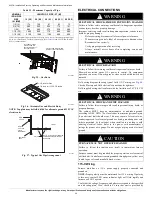
935CA: Installation, Start-up, Operating and Service and Maintenance Instructions
Manufacturer reserves the right to change, at any time, specifications and designs without notice and without obligations.
30
A190371
Fig. 47 – Two-Stage Thermostat with 1-Speed Variable Furnace and
Two-Speed Air Conditioner
NOTES FOR THERMOSTATS
1. Heat pump MUST have a high pressure switch for dual fuel
applications.
2. Refer to outdoor equipment Installation Instructions for additional
information and setup procedure.
3. If the heat pump date code is 1501E or earlier, select the “ZONE”
position on the two-speed heat pump control. Heat pumps having
date codes 1601E and later do not have or require a “ZONE”
selection.
4. Outdoor Air Temperature Sensor must be attached in all dual fuel
applications.
5. Dip switch No. 1 on Thermidistat should be set in OFF position for
air conditioner installations. This is factory default.
6. Dip switch No. 1 on Thermidistat should be set in ON position for
heat pump installations.
7. Dip switch No. 2 on Thermidistat should be set in OFF position for
single-speed compressor operation. This is factory default.
8. Dip switch No. 2 on Thermidistat should be set in ON position for
two-speed compressor operation.
9. Configuration Option No. 10 “Dual Fuel Selection” must be turned
ON in all dual fuel applications.
10. NO connection should be made to the furnace HUM terminal when
using a Thermidistat.
11. Optional connection: If wire is connected, ACRDJ jumper on
furnace
control
should
be
removed
to
allow
Thermidistat/Thermostat to control outdoor unit staging.
12. The RVS Sensing terminal “L” should not be connected. This is
internally used to sense defrost operation.
13. DO NOT SELECT the “FURNACE INTERFACE” or “BALANCE
POINT” option on the two-speed heat pump control board. This is
controlled internally by the Thermidistat/Dual Fuel Thermostat.
14. Dip switch D on Dual Fuel Thermostat should be set in OFF
position for single-speed compressor operation. This is factory
default.
15. Dip switch D on Dual Fuel Thermostat should be set in ON position
for two-speed compressor operation.
VENTING
NOTE:
Planning for the venting system should be done in conjunction
with planning for the ductwork, drainage, and furnace accessories, such
as air cleaners and humidifiers. Begin assembling the venting system
AFTER
the furnace is set in place in the required orientation.
Venting for this furnace shall follow all Local codes for Category IV
venting systems. This furnace is CSA approved for venting with
PVC/ABS DWV venting systems. This furnace is also CSA approved
for venting with M&G DuraVent
R
PolyPro
R
or Centrotherm
InnoFlue
R
polypropylene venting systems using single wall straight and
flex, and required fittings (elbows, reducers, increasers, connectors,
adapters) only.
NOTE:
THESE INSTRUCTIONS
DO NOT
CONTAIN DETAILED
INSTALLATION INSTRUCTIONS FOR POLYPROPYLENE
VENTING SYSTEMS. Refer to the polypropylene venting system
manufacturer’s installation instructions for the polypropylene venting
system installation.
NOTE:
When using polypropylene venting systems, all venting
materials used, including the vent terminations, must be from the same
manufacturer.
See notes 2, 11
WARNING
!
CARBON MONOXIDE POISONING HAZARD
Failure to follow the steps outlined below for each appliance connected
to the venting system being placed into operation could result in carbon
monoxide poisoning or death.
The following steps shall be followed for each appliance connected to
the venting system being placed into operation, while all other
appliances connected to the venting system are not in operation:
1. Seal any unused openings in venting system.
2. Inspect the venting system for proper size and horizontal pitch, as
required in the National Fuel Gas Code, ANSI Z223.1/NFPA 54 or
the CSA B149 Natural Gas and Propane Installation Code and
these instructions. Determine that there is no blockage or
restriction, leakage, corrosion and other deficiencies, which could
cause an unsafe condition.
3. As far as practical, close all building doors and windows and all
doors between the space in which the appliance(s) connected to
the venting system are located and other spaces of the building.
4. Close fireplace dampers.
5. Turn on clothes dryers and any appliance not connected to the
venting system. Turn on any exhaust fans, such as range hoods and
bathroom exhausts, so they are operating at maximum speed. Do
not operate a summer exhaust fan.
6. Follow the lighting instructions. Place the appliance being
inspected into operation. Adjust the thermostat so appliance is
operating continuously.
7. Test for spillage from draft hood equipped appliances at the draft
hood relief opening after 5 minutes of main burner operation. Use
the flame of a match or candle.
8. If improper venting is observed during any of the above tests, the
venting system must be corrected in accordance with the National
Fuel Gas Code, ANSI Z223.1/NFPA 54 and/or CSA B149.1
Natural Gas and Propane Installation Code.
9. After it has been determined that each appliance connected to the
venting system properly vents when tested as outlined above,
return doors, windows, exhaust fans, fireplace dampers and any
other gas-fired burning appliance to their previous conditions of
use.
















































